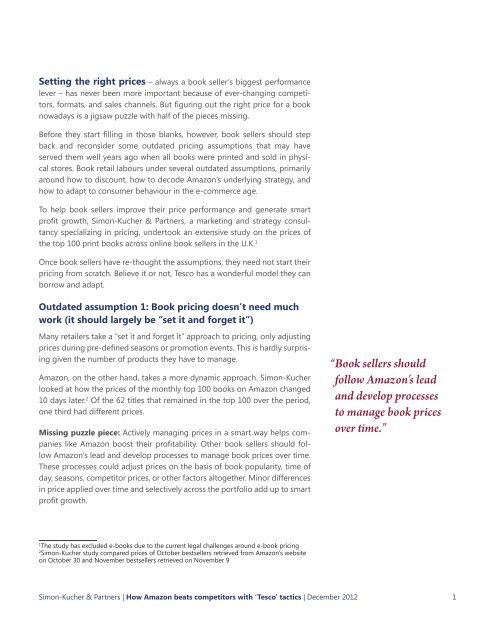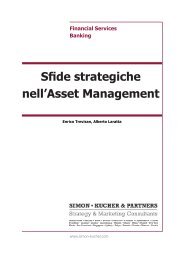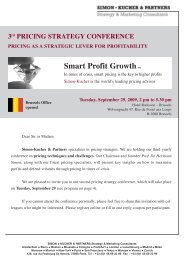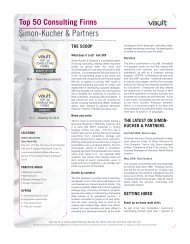How Amazon beats competitors with - Simon-Kucher & Partners
How Amazon beats competitors with - Simon-Kucher & Partners
How Amazon beats competitors with - Simon-Kucher & Partners
- No tags were found...
You also want an ePaper? Increase the reach of your titles
YUMPU automatically turns print PDFs into web optimized ePapers that Google loves.
Setting the right prices – always a book seller’s biggest performancelever – has never been more important because of ever-changing <strong>competitors</strong>,formats, and sales channels. But figuring out the right price for a booknowadays is a jigsaw puzzle <strong>with</strong> half of the pieces missing.Before they start filling in those blanks, however, book sellers should stepback and reconsider some outdated pricing assumptions that may haveserved them well years ago when all books were printed and sold in physicalstores. Book retail labours under several outdated assumptions, primarilyaround how to discount, how to decode <strong>Amazon</strong>’s underlying strategy, andhow to adapt to consumer behaviour in the e-commerce age.To help book sellers improve their price performance and generate smartprofit growth, <strong>Simon</strong>-<strong>Kucher</strong> & <strong>Partners</strong>, a marketing and strategy consultancyspecializing in pricing, undertook an extensive study on the prices ofthe top 100 print books across online book sellers in the U.K. 1Once book sellers have re-thought the assumptions, they need not start theirpricing from scratch. Believe it or not, Tesco has a wonderful model they canborrow and adapt.Outdated assumption 1: Book pricing doesn’t need muchwork (it should largely be “set it and forget it”)Many retailers take a “set it and forget it” approach to pricing, only adjustingprices during pre-defined seasons or promotion events. This is hardly surprisinggiven the number of products they have to manage.<strong>Amazon</strong>, on the other hand, takes a more dynamic approach. <strong>Simon</strong>-<strong>Kucher</strong>looked at how the prices of the monthly top 100 books on <strong>Amazon</strong> changed10 days later. 2 Of the 62 titles that remained in the top 100 over the period,one third had different prices.Missing puzzle piece: Actively managing prices in a smart way helps companieslike <strong>Amazon</strong> boost their profitability. Other book sellers should follow<strong>Amazon</strong>’s lead and develop processes to manage book prices over time.These processes could adjust prices on the basis of book popularity, time ofday, seasons, competitor prices, or other factors altogether. Minor differencesin price applied over time and selectively across the portfolio add up to smartprofit growth.“ Book sellers shouldfollow <strong>Amazon</strong>’s leadand develop processesto manage book pricesover time.”1The study has excluded e-books due to the current legal challenges around e-book pricing2<strong>Simon</strong>-<strong>Kucher</strong> study compared prices of October bestsellers retrieved from <strong>Amazon</strong>’s websiteon October 30 and November bestsellers retrieved on November 9<strong>Simon</strong>-<strong>Kucher</strong> & <strong>Partners</strong> | <strong>How</strong> <strong>Amazon</strong> <strong>beats</strong> <strong>competitors</strong> <strong>with</strong> ‘Tesco’ tactics | December 2012 1
















